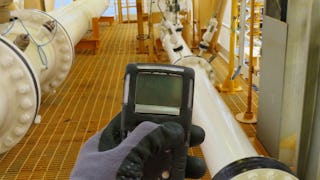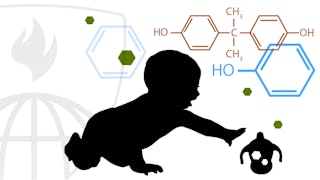This course aims to provide process safety experience for engineers, particularly relevant to chemical engineering but applicable to any field involving process operations. This course introduces you to the important, practical, value-added skills and information that will aid your career, or preparation for a career, in chemical process engineering. These skills include improving your ability to identify and quantify toxic chemical hazards and be able to identify and mitigate scenarios where reactive chemical hazards are present. You will be able to describe the importance of pressure protection and the general process for pressure relief system design all while using lessons learned from past chemical process incidents to inform the implementation of safer solutions and work practices.


Chemical Hazards: Toxicology & Reactivity
本课程是 Chemical Hazards and Process Safety 专项课程 的一部分

位教师:Jason White
4,675 人已注册
包含在  中
中
了解顶级公司的员工如何掌握热门技能

积累特定领域的专业知识
- 向行业专家学习新概念
- 获得对主题或工具的基础理解
- 通过实践项目培养工作相关技能
- 获得可共享的职业证书

该课程共有4个模块
After this module, you will be able to define industrial health and hygiene including important regulatory agencies. You'll be able to describe chemical hazards and the importance of understanding these hazards. You will be able to describe how chemical reactions, when not managed properly, can result in catastrophic scenarios. Finally, you will be able to use the Globally Harmonized System (GHS) for Safety Data Sheets and Labels as well as the National Fire Protection Association (NFPA) diamond.
涵盖的内容
7个视频1篇阅读材料1个作业2个讨论话题
After this module, you will be able to define, discuss, and use exposure limits such as threshold limit value (TLV) and permissible exposure limit (PEL). You will be able to describe effects of toxicants and quantify impact of exposure using dose versus response curves. You will be able to describe control techniques to prevent exposures, as well as use lessons from past chemical process safety incidents to inform the implementation of solutions and work practices.
涵盖的内容
6个视频1个作业2个讨论话题
After this module, you will be able to identify processes and situations where reactive chemical hazards are likely to be present. You will be able to create and use a chemical compatibility matrix. And finally, you will be able to describe how to use calorimeter data to characterize chemical reactions.
涵盖的内容
8个视频2篇阅读材料1个作业1个讨论话题
At the end of this module, you will be able to explain the importance of pressure protection and define key terms related to pressure relief devices. You will be able to identify major classes of relief devices and be able to describe options for handling relief effluent. Finally, you'll be able to describe the general process for relief system design.
涵盖的内容
7个视频1个作业2个讨论话题
获得职业证书
将此证书添加到您的 LinkedIn 个人资料、简历或履历中。在社交媒体和绩效考核中分享。
位教师

从 Chemistry 浏览更多内容
 状态:免费试用
状态:免费试用University of California, Davis
 状态:免费试用
状态:免费试用University of California, Davis
 状态:免费试用
状态:免费试用University of California, Davis
 状态:免费
状态:免费Johns Hopkins University
人们为什么选择 Coursera 来帮助自己实现职业发展




常见问题
To access the course materials, assignments and to earn a Certificate, you will need to purchase the Certificate experience when you enroll in a course. You can try a Free Trial instead, or apply for Financial Aid. The course may offer 'Full Course, No Certificate' instead. This option lets you see all course materials, submit required assessments, and get a final grade. This also means that you will not be able to purchase a Certificate experience.
When you enroll in the course, you get access to all of the courses in the Specialization, and you earn a certificate when you complete the work. Your electronic Certificate will be added to your Accomplishments page - from there, you can print your Certificate or add it to your LinkedIn profile.
Yes. In select learning programs, you can apply for financial aid or a scholarship if you can’t afford the enrollment fee. If fin aid or scholarship is available for your learning program selection, you’ll find a link to apply on the description page.
更多问题
提供助学金,




